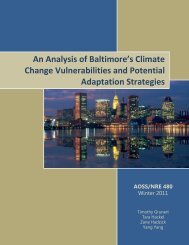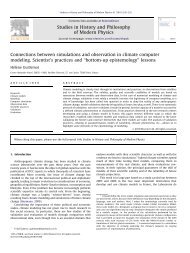Lal, Carbon Sequestration, PhilTransRoySoc 2008
Lal, Carbon Sequestration, PhilTransRoySoc 2008
Lal, Carbon Sequestration, PhilTransRoySoc 2008
You also want an ePaper? Increase the reach of your titles
YUMPU automatically turns print PDFs into web optimized ePapers that Google loves.
Downloaded from rstb.royalsocietypublishing.org on April 14, 2010<strong>Carbon</strong> sequestrationRattan <strong>Lal</strong>*Phil. Trans. R. Soc. B (<strong>2008</strong>) 363, 815–830doi:10.1098/rstb.2007.2185Published online 30 August 2007<strong>Carbon</strong> Management and <strong>Sequestration</strong> Center, The Ohio State University, Columbus, OH 43210, USADeveloping technologies to reduce the rate of increase of atmospheric concentration of carbondioxide (CO 2 ) from annual emissions of 8.6 Pg C yr –1 from energy, process industry, land-useconversion and soil cultivation is an important issue of the twenty-first century. Of the three optionsof reducing the global energy use, developing low or no-carbon fuel and sequestering emissions, thismanuscript describes processes for carbon (CO 2 ) sequestration and discusses abiotic and biotictechnologies. <strong>Carbon</strong> sequestration implies transfer of atmospheric CO 2 into other long-lived globalpools including oceanic, pedologic, biotic and geological strata to reduce the net rate of increase inatmospheric CO 2 . Engineering techniques of CO 2 injection in deep ocean, geological strata, old coalmines and oil wells, and saline aquifers along with mineral carbonation of CO 2 constitute abiotictechniques. These techniques have a large potential of thousands of Pg, are expensive, have leakagerisks and may be available for routine use by 2025 and beyond. In comparison, biotic techniques arenatural and cost-effective processes, have numerous ancillary benefits, are immediately applicablebut have finite sink capacity. Biotic and abiotic C sequestration options have specific nitches, arecomplementary, and have potential to mitigate the climate change risks.Keywords: climate change; greenhouse effect; soil management; geological sequestration;chemical sequestration; oceanic sequestration1. INTRODUCTIONGlobal surface temperatures have increased by 0.88Csince the late nineteenth century, and 11 out of the12 warmest years on record have occurred since 1995(IPCC 2007). Earth’s mean temperature is projectedto increase by 1.5–5.88C during the twenty-firstcentury (IPCC 2001).Therateofincreaseinglobaltemperature has been 0.158C per decade since 1975.In addition to the sea-level rise of 15–23 cm duringthe twentieth century (IPCC 2007), there have beennotable shifts in ecosystems (Greene & Pershing2007) and frequency and intensity of occurrence ofwild fires (Running 2006; Westerling et al. 2006).These and other observed climate changes arereportedly caused by emission of greenhouse gases(GHGs) through anthropogenic activities includingland-use change, deforestation, biomass burning,draining of wetlands, soil cultivation and fossil fuelcombustion. Consequently, the concentration ofatmospheric GHGs and their radiative forcing haveprogressively increased with increase in humanpopulation, but especially so since the onset ofindustrial revolution around 1850. The concentrationof carbon dioxide (CO 2 ) has increased by31% from 280 ppmv in 1850 to 380 ppmv in 2005,and is presently increasing at 1.7 ppmv yr K1 or0.46% yr K1 (WMO 2006; IPCC 2007). Concentrationsof methane (CH 4 ) and nitrous oxide (N 2 O)have also increased steadily over the same period(IPCC 2001, 2007; Prather et al. 2001; WMO 2006).Total radiative forcing, externally imposed perturbationin the radiative energy budget of the Earth’s*lal.1@osu.eduOne contribution of 15 to a Theme Issue ‘Sustainable agriculture II’.climate system (Ramaswamy et al. 2001), of allGHGs since 1850 is estimated at 2.43 W m K2 (IPCC2001, 2007).There is a strong interest in stabilizing the atmosphericabundance of CO 2 and other GHGs to mitigatethe risks of global warming (Kerr 2007; Kintisch 2007b;Kluger 2007; Walsh 2007). There are three strategies oflowering CO 2 emissions to mitigate climate change(Schrag 2007): (i) reducing the global energy use,(ii) developing low or no-carbon fuel, and (iii)sequestering CO 2 from point sources or atmospherethrough natural and engineering techniques. Between1850 and 1998, anthropogenic emissions are estimatedat 270G30 Pg by fossil fuel combustion and at136G30 Pg by land-use change, deforestation and soilcultivation (IPCC 2001). Presently, approximately7PgCyr K1 is emitted by fossil fuel combustion(Pacala & Socolow 2004) and 1.6 Pg C yr K1 bydeforestation, land-use change and soil cultivation. Ofthe total anthropogenic emissions of 8.6 Pg C yr K1 ,3.5 Pg C yr K1 is absorbed by the atmosphere,2.3 Pg C yr K1 by the ocean and the remainder by anunidentified terrestrial sink probably in the NorthernHemisphere (Tans et al. 1990; Fan et al. 1998).The objective of this paper is to discuss the processand technological options of CO 2 –C sequestration inone of the long-lived global C pools so as to reduce thenet rate of increase of atmospheric concentration ofCO 2 . While CO 2 –C sequestration is discussed ingeneral, specific attention is given to the terrestrial Csequestration in forests and soils.2. THE GLOBAL CARBON CYCLEThe importance of atmospheric concentration of CO 2on global temperature was recognized by Arrhenius815 This journal is q 2007 The Royal Society




